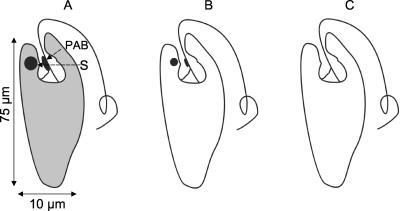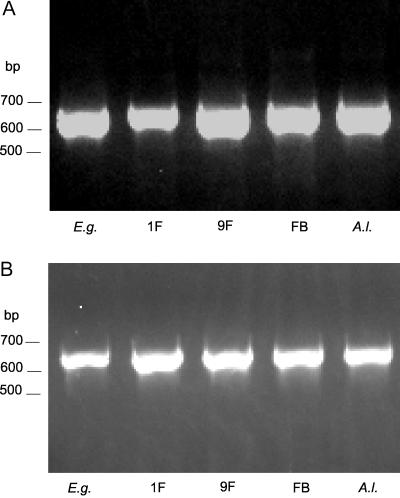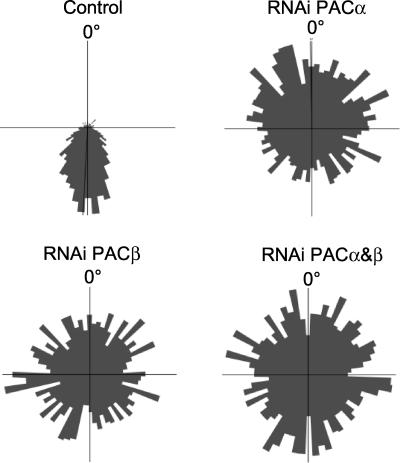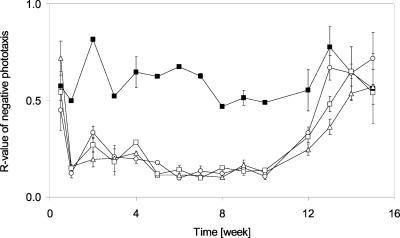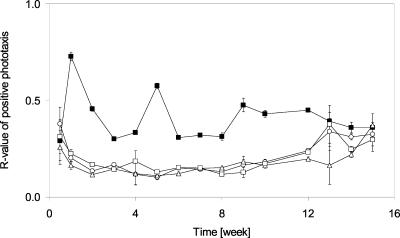Abstract
Euglena gracilis, a unicellular freshwater protist exhibits different photomovement responses, such as phototaxis (oriented movement toward or away from the light source) and photophobic (abrupt turn in response to a rapid increase [step-up] or decrease [step-down] in the light fluence rate) responses. Photoactivated adenylyl cyclase (PAC) has been isolated from whole-cell preparations and identified by RNA interference (RNAi) to be the photoreceptor for step-up photophobic responses but not for step-down photophobic responses (M. Iseki, S. Matsunaga, A. Murakami, K. Ohno, K. Shiga, C. Yoshida, M. Sugai, T. Takahashi, T. Hori, M. Watanabe [2002] Nature 415: 1047-1051). The present study shows that knockdown of PAC by RNAi also effectively suppresses both positive and negative phototaxis, indicating for the first time that PAC or a PAC homolog is also the photoreceptor for photoorientation of wild-type E. gracilis. Recovery from RNAi occurred earlier for step-up photophobic responses than for positive and negative phototaxis. In addition, we investigated several phototaxis mutant strains of E. gracilis with different cytological features regarding the stigma and paraxonemal body (PAB; believed to be the location for the phototaxis photoreceptor) as well as Astasia longa, a close relative of E. gracilis. All of the E. gracilis mutant strains had PAC mRNAs, whereas in A. longa, a different but similar mRNA was found and designated AlPAC. Consistently, all of these strains showed no phototaxis but performed step-up photophobic responses, which were suppressed by RNAi of the PAC mRNA. The fact that some of these strains possess a cytologically altered or no PAB demonstrates that at least in these strains, the PAC photoreceptor responsible for the step-up photophobic responses is not located in the PAB.
The protist Euglena gracilis, a unicellular freshwater flagellate, is capable of both autotrophy and heterotrophy. The cell is characterized (Fig. 1A) by one flagellum emerging from the reservoir (invagination of the anterior plasma membrane) and a second non-emerging flagellum. The paraxonemal body (PAB) is a photosensing organelle (Ghetti et al., 1985) located inside the reservoir close to the connecting point of the two flagella. The stigma, formerly known as the eyespot, is positioned inside the cytoplasm and adjacent to the PAB. It contains carotenoids and is not involved in photosensing, as initially thought, but contributes to photoorientation (Lebert and Häder, 1997) by shading the PAB as the cell rotates around its longitudinal axis during forward swimming. A detailed description of E. gracilis can be found in Buetow (1968).
Figure 1.
Anatomical features of the strains. E. gracilis wild type (A) with chloroplasts and normal PAB and stigma (S). Mutant strain FB (B) without chloroplasts and smaller than normal PAB and stigma. Astasia longa wild type and E. gracilis mutant strains 1F and 9F (C) also without chloroplasts and no detectable PAB and stigma.
E. gracilis uses light and gravity for orientation to move to and stay at optimal growth conditions in the water column. Light-induced responses (Lebert and Häder, 2000) can be categorized into photokinesis, a light-dependent swimming velocity; phototaxis, an oriented movement toward (positive phototaxis) or away (negative phototaxis) from the light source (Häder et al., 1981); and photophobic responses (Mikolajczyk, 1984; Walne et al., 1984; Doughty, 1993). The latter ones occur when the cells experience a sudden change in light intensity and are characterized by a period of tumbling and subsequent swimming seemingly in a random direction. Photophobic responses caused by an abrupt increase in light fluence rate are called step-up photophobic responses. Those caused by an abrupt decrease are referred to as step-down photophobic responses. Recently, the receptor of step-up photophobic responses in E. gracilis has been isolated and identified (Iseki et al., 2002) to be a flavoprotein photoactivated adenylyl cyclase (PAC). PAC represents a novel blue-light receptor consisting of two α-subunits (PACα) and two β-subunits (PACβ). Each subunit contains two flavin-binding domains and two adenylyl cyclase catalytic domains (Iseki et al., 2002). Excitation of the receptor protein in vitro by UV-17 blue light (peaks at 370 and 450 nm) results in the formation of cAMP, which is thought to alter the flagellar beat pattern and trigger step-up photophobic responses. The overall similarity between PACα and PACβ is 72% at the nucleotide level. Reverse genetics (RNA interference [RNAi]; see below) revealed that PAC is not the photoreceptor of step-down photophobic responses (Iseki et al., 2002), which is consistent with the different action spectrum of this response (Matsunaga et al., 1998). The photoreceptor of phototaxis was up to now also unknown, but action spectroscopy suggested the involvement of flavins and pterins (Brodhun and Häder, 1990; Häder and Lebert, 1998). Other researchers proposed that the phototaxis receptor is not a flavoprotein but a rhodopsin-like protein (Walne et al., 1998; Barsanti et al., 2000).
The aim of the present study was to investigate the function of PAC in step-up photophobic responses in colorless E. gracilis mutants and in A. longa, a non-photosynthetic close relative of E. gracilis which lacks a PAB. Furthermore, we aimed at clarifying the role of PAC in both positive and negative phototaxis in wild-type E. gracilis.
RESULTS
Presence and Localization of PAC or PAC Homolog in E. gracilis Mutants and A. longa
The presence of an intact PAB has been detected only in the cells of wild-type E. gracilis (normal PAB; Fig. 1A) and the mutant strain FB (smaller PAB; Fig. 1B) by autofluorescence and light microscopy, whereas no PAB was detected in the strains 1F and 9F, as well as in A. longa (Fig. 1C; Lebert and Häder, 1997). Irrespective of the presence of an intact PAB, PAC mRNAs were detected by reverse transcriptase-PCR in all of the E. gracilis strains (Fig. 2, A and B).
Figure 2.
The 5′-end fragment of PACα (A) and PACβ (B) detected with the same set of primers by PCR in E. gracilis wild type (E.g.) and in mutant strains 1F, 9F, and FB. AlPACα and AlPACβ of A. longa (A.l.) were amplified with AlPAC specific primers.
After several attempts to detect PACα and PACβ in A. longa by reverse transcriptase-PCR, we found two similar but distinct mRNAs. The deduced amino acid sequences were very similar to PACα and PACβ. Because consensus amino acids in the flavin-binding domains and those in the adenylyl cyclase catalytic domains are conserved well, these proteins are expected to constitute an adenylyl cyclase that can be activated by light. The proteins, which seem to be orthologs of PACα and PACβ, were named AlPACα and AlPACβ, respectively (accession nos. AB085169 and AB085170; Table I).
Table I.
Anatomical and molecular characteristics of strains Presence of chloroplasts, stigma, and that of PAB as observed by autofluorescence (PAB autofl.) has been published previously (Lebert and Häder, 1997). PAC and AlPAC genes were detected by PCR (Fig. 5A and B). Strains: E. gracilis wild type (E. w+), E. gracilis mutant strains (1F, 9F, FB), and A. longa wild type (A. w+). +, Presence of a feature; -, absence of a feature.
| Chloroplasts | Stigma | PAB autofl. | PAC PCR | AIPAC PCR | |
|---|---|---|---|---|---|
| E. w+ | + | + | + | + | — |
| 1F | — | — | — | + | — |
| 9F | — | — | — | + | — |
| FB | — | + | ± | + | — |
| A. w+ | — | — | — | — | + |
Upon examination of the role of PAC in photomovement responses in these strains by RNAi, step-up photophobic responses were suppressed in all of the strains tested regardless of their anatomical and molecular differences. RNAi for one of the PAC subunits was sufficient to suppress the responses. Recovery of step-up photophobic responses occurred first in A. longa (3 weeks) followed by the other strains (5-6 weeks).
Involvement of PAC in Phototaxis
Among all strains investigated, only wild-type E. gracilis exhibits normal phototaxis; we therefore examined the possible function of PAC in phototaxis in this strain quantitatively using an in-house-developed computerized motion analysis system (Häder and Lebert, 2000). Gene silencing of PAC by RNAi resulted in complete suppression of negative and positive phototaxis (Fig. 3). This suppression persisted for more than 2 months (Figs. 4 and 5). As in the case of step-up photophobic responses, no differences were observed between silencing PACα or PACβ alone or both subunits.
Figure 3.
Tracks of cells at high irradiances summarized in circular histograms. Control cells swimming with high precision away from the light source (800 W m-2 at 0°) and RNAi-treated cells showing random swimming.
Figure 4.
The effects of PAC on negative phototaxis of E. gracilis without RNAi (black squares) and after RNAi against PACα (white circles), PACβ (white triangles), and PACα&β (white squares). Silencing of PAC inhibited negative phototaxis as indicated by the decreased r value, an indicator of the precision of orientation.
Figure 5.
The effects of PAC on positive phototaxis of E. gracilis without RNAi (black squares) and after RNAi of each or both PAC subunit(s) (white symbols). Inhibition of positive phototaxis lasted for more than 2 months, similar to negative phototaxis.
Recovery of phototaxis, however, differed significantly from that of step-up responses: Whereas the suppression of step-up photophobic responses persisted for up to 6 weeks, suppression of phototaxis persisted for more than 3 months (Figs. 4 and 5). Both positive and negative phototaxis reappeared almost simultaneously. Other parameters observed by motion analysis, including velocity and form factor (indicator of cell shape), remained normal after RNAi (data not shown), indicating that the silencing process did not affect such cell functions.
DISCUSSION
Light is an important parameter for growth of E. gracilis. Although E. gracilis can live heterotrophically, optimal growth occurs in light. Positive phototaxis, supported by negative gravitaxis (Lebert et al., 1999), leads the cells to the light source to facilitate photosynthesis, whereas negative phototaxis protects the cells from damage induced by excessive solar radiation at the water surface. So far, the photoreceptor had been characterized only for step-up photophobic responses (Iseki et al., 2002). Here, we demonstrate that PAC is responsible not only for the step-up photophobic responses in the wild type but also in all E. gracilis mutant strains investigated, even in those with a smaller PAB (mutant strain FB) or without a visible PAB (mutant strains 1F and 9F). Therefore the presence of a PAB is not a necessary prerequisite for step-up photophobic responses. Furthermore, A. longa, a colorless close relative of E. gracilis, lacks a PAB altogether but shows step-up photophobic responses that were also inhibited by RNAi. This result strongly confirms that the PAB is not necessary for step-up photophobic responses. At least in these cases, PAC or AlPAC must be located somewhere else in the cell, e.g. in the flagellum. The chloroplasts are not the location because all strains investigated except for wild-type E. gracilis do not possess chloroplasts.
RNAi is a powerful tool that has been applied to a wide range of organisms from unicellular protists (Ngo et al., 1998) to mammals (Zhang et al., 2003). Studies conducted so far indicate that specificity of RNAi depends mainly on the organism. Nonspecific degradation of homolog genes has been described for lower eukaryotes (Alder et al., 2003) and plants (Hamilton et al., 2002). In contrast, RNAi is highly specific in mammals (Elbashir et al., 2001; Chi et al., 2003) when assayed with small interfering RNAs of 21 bp in length. Nonspecific degradation of mRNAs can also be triggered in mammals if longer double-stranded RNA (dsRNA) is used leading to general inhibition of translation (Bass, 2001). The interference of E. gracilis PAC dsRNA with A. longa AlPAC mRNA indicates a nonspecific inhibition also found in other lower eukaryotes.
In addition to step-up photophobic responses, gene silencing of PAC inhibited phototaxis, another light-dependent response of E. gracilis. Inhibition occurred for positive as well as for negative phototaxis and was characterized by random swimming. Interestingly, recovery occurred simultaneously for positive and negative phototaxis but significantly later than for step-up photophobic responses in the same cells. Either a lower threshold level of requirement of PAC in the latter or sequential recovery of the PAC compartmentation for the two different photomovement responses would be a possible explanation.
These data suggest, but do not give definite proof, that the PAC receptor responsible for step-up photophobic responses also serves as photoreceptor for phototaxis. Alternatively, a related PAC homolog might be responsible for light perception for phototaxis in E. gracilis. If the latter option is the case, the PAC homolog might be degraded nonspecifically as shown for AlPAC. Finally, PAC could influence downstream events in phototaxis.
CONCLUSIONS
PAC is the photoreceptor of step-up photophobic responses in E. gracilis wild type and the mutant strains 1F, 9F, and FB as well as in A. longa, a close relative of E. gracilis. Because in some strains, the PAB has an altered structure or is even absent, the PAC photoreceptor for step-up photophobic responses must have a different location in the cell. A PAC photoreceptor also controls positive and negative phototaxis of E. gracilis (wild type). Knockdown cells could not orient in low- and high-light conditions, and swimming was at random.
MATERIALS AND METHODS
Strains and Culture Conditions
Euglena gracilis Z wild type, mutant strains 1F (1224-5/1F), 9F (1224-5/9F), and Astasia longa wild type were obtained from Sammlung für Algenkulturen (Göttingen, Germany). Mutant strain FB was a kind gift of Prof. R. Hertel (University Freiburg, Freiburg, Germany) originally isolated by Dr. L. Barsanti (Consiglio Nazionale delle Ricerche, Pisa, Italy). All strains were grown in a rich medium described previously (Starr, 1964) at 22°C under low-light conditions (25 W m-2) in static Erlenmeyer flasks.
Identification of AlPAC
Total RNAs were purified from 7-d-old culture of A. longa using RNeasy Plant Mini Kit (Qiagen, Hilden, Germany). First-strand cDNAs were synthesized using ReverTra Ace (TOYOBO, Osaka) and the Oligo dT 3 sites Adaptor Primer (TaKaRa, Ohtsu). PCR amplification of the cDNA was done with LA-TaqDNA polymerase (TaKaRa) and sets of primers originally designed for PACα (EgBR2S18, 5′-GGTGTATGGCAGTCCCTTG-3′; EgBR2A10, 5′-TCAACCTCCATCACACGAG-3′) and PACβ (EgBR3S7, 5′-ACATCTCGCAAGCCACTC-3′; EgBR3A7, 5′-CCGCTTGATGGAATCGAC-3′). According to the sequence of the PCR products, specific primers for AlPACα (EgBR5S1, 5′-GGCTCTCCCCCAAGTTAC-3′; EgBR5A1, 5′-GACAACCTCCACTGAGACG-3′) and AlPACβ (EgBR4S1, 5′-CATCACTGGAACACTTCTCTATG-3′; EgBR4A1, 5′-GTGAGTGTCCATTCTGCTG-3′) were synthesized. 5′ ends of the cDNAs encoding AlPACα and AlPACβ were amplified by PCR using the specific reverse primers and the primer (EgLS1, 5′-CTTTACTAGTGTCTATTTTTTTTCG-3′) that was designed according to the consensus sequence of the leader sequence of E. gracilis mRNAs (Tessier et al., 1991). 3′ ends of the cDNAs were extended by conventional 3′-RACE technique using the specific forward primers and the 3 sites Adaptor Primer (TaKaRa, Japan). Sequences of the PCR products were determined by direct sequencing using DYEnamic ET Terminator Cycle Sequencing Kit (Amersham Biosciences, Piscataway, NJ) and ABI PRISM 310 (Applied Biosystems, Foster City, CA).
RNAi
Knockdown of PAC by RNAi was accomplished by synthesizing dsRNA fragments corresponding to the N-terminal site of PACα and PACβ. These fragments of 616 bases for PACα and 618 bases for PACβ contained the first flavin-binding domain in both subunits. Each strain was treated three times with RNAi for PACα and PACβ alone and both subunits simultaneously. dsRNA was generated as described (Iseki et al., 2002; supplemental material at http://www.nature.com). The procedure entails amplification of a fragment corresponding to the 5′ end of each gene from pGEM (Promega, Madison, WI) containing either PACα or PACβ cDNA with Pfx proofreading polymerase (Invitrogen, Carlsbad, CA). A T7 promoter was ligated to the products using the Lig'nScribe Kit (Ambion, Austin, TX). After amplification using one gene-specific primer corresponding to the 5′ or 3′ and a T7 primer, the products were transcribed into single-stranded RNA using MEGAscript (Ambion). The sense and antisense single-stranded RNA were annealed to generate dsRNA and were introduced into the cells by electroporation. Control cells were electroporated with buffer only. Cells were electroporated only once, and the effects of RNAi were monitored subsequently on subcultures. To maintain similar cell densities of about 1 × 105 to 1 × 106 cells mL-1, cells were subcultured once a week by inoculating 1 mL of a 1-week-old culture into 40 mL of fresh medium given that the division rate is about one division per day.
Step-Up Photophobic Responses and Phototaxis
Motion analysis was conducted with a computer-based cell tracking system using Wintrack 2000 (Häder and Lebert, 2000). Before measurement, cells were adapted to darkness for 1 h, and all further manipulations were performed under dim red light. For observation, cells were transferred into glass chambers consisting of two microscope slides sealed at the edges with silicone. The light source was a slide projector and desired intensities were achieved using neutral glass filters. The fluence rate was 800 W m-2 for step-up photophobic responses and negative phototaxis and 10 W m-2 for positive phototaxis. Cells were tracked for 2 min, and all measurements were done in duplicate. Precision of orientation was described by the r value, a statistical parameter ranging from 0 (random orientation) to 1 (perfect orientation; Batschelet, 1981). Cell shape was calculated from the form factor starting from 1 (round cells) and increasing as the cells become more elongated. The elongated cells of E. gracilis tend to become more rounded in various conditions like the presence of toxins or excessive irradiances. The form factor is therefore used as an indicator for cell fitness. At the time of measurement, cultures were 1 week old.
Article, publication date, and citation information can be found at www.plantphysiol.org/cgi/doi/10.1104/pp.103.034223.
References
- Alder MN, Dames S, Gaudet J, Mango SE (2003) Gene silencing in Caenorhabditis elegans by transitive RNA interference. RNA 9: 25-32 [DOI] [PMC free article] [PubMed] [Google Scholar]
- Barsanti L, Passarelli V, Walne PL, Gualtieri P (2000) The photoreceptor protein of Euglena gracilis. FEBS Lett 482: 247-251 [DOI] [PubMed] [Google Scholar]
- Bass BL (2001) RNA interference. The short answer. Nature 411: 428-429 [DOI] [PubMed] [Google Scholar]
- Batschelet E (1981) Circular Statistics in Biology. Academic Press, London, New York
- Brodhun B, Häder D-P (1990) Photoreceptor proteins and pigments in the paraflagellar body of the flagellate Euglena gracilis. Photochem Photobiol 52: 865-871 [Google Scholar]
- Buetow DE (1968) The Biology of Euglena. Academic Press, New York
- Chi JT, Chang HY, Wang NN, Chang DS, Dunphy N, Brown PO (2003) Genomewide view of gene silencing by small interfering RNAs. Proc Natl Acad Sci USA 100: 6343-6346 [DOI] [PMC free article] [PubMed] [Google Scholar]
- Doughty MJ (1993) Step-up photophobic response of Euglena gracilis at different irradiances. Acta Protozool 32: 73-77 [Google Scholar]
- Elbashir SM, Harborth J, Lendeckel W, Yalcin A, Weber K, Tuschl T (2001) Duplexes of 21-nucleotide RNAs mediate RNA interference in cultured mammalian cells. Nature 411: 494-498 [DOI] [PubMed] [Google Scholar]
- Ghetti F, Colombetti G, Lenci F, Campani E, Polacco E, Quaglia M (1985) Fluorescence of Euglena gracilis photoreceptor pigment: an in vitro microspectrofluorometric study. Photochem Photobiol 42: 29-33 [Google Scholar]
- Häder D-P, Colombetti G, Lenci F, Quaglia M (1981) Phototaxis in the flagellates, Euglena gracilis and Ochromonas danica. Arch Microbiol 130: 78-82 [Google Scholar]
- Häder D-P, Lebert M (1998) The photoreceptor for phototaxis in the photosynthetic flagellate Euglena gracilis. Photochem Photobiol 68: 260-265 [Google Scholar]
- Häder D-P, Lebert M (2000) Real-time tracking of microorganisms. In D-P Häder, ed, Image Analysis: Methods and Applications. CRC Press, Boca Raton, FL, pp 393-422
- Hamilton A, Voinnet O, Chappell L, Baulcombe D (2002) Two classes of short interfering RNA in RNA silencing. EMBO J 21: 4671-4679 [DOI] [PMC free article] [PubMed] [Google Scholar]
- Iseki M, Matsunaga S, Murakami A, Ohno K, Shiga K, Yoshida C, Sugai M, Takahashi T, Hori T, Watanabe M (2002) A blue-light-activated adenylyl cyclase mediates photoavoidance in Euglena gracilis. Nature 415: 1047-1051 [DOI] [PubMed] [Google Scholar]
- Lebert M, Häder D-P (1997) Behavioral mutants of Euglena gracilis: functional and spectroscopic characterization. J Plant Physiol 151: 188-195 [DOI] [PubMed] [Google Scholar]
- Lebert M, Häder D-P (2000) Photoperception and phototaxis in flagellated algae. Res Adv Photochem Photobiol 1: 201-226 [Google Scholar]
- Lebert M, Porst M, Richter P, Häder D-P (1999) Physical characterization of gravitaxis in Euglena gracilis. J Plant Physiol 155: 338-343 [DOI] [PubMed] [Google Scholar]
- Matsunaga S, Hori T, Takahashi T, Kubota M, Watanabe M, Okamoto K, Masuda K, Sugai M (1998) Discovery of signaling effect of UV-B/C light in the extended UV-A/blue-type action spectra for step-down and step-up photophobic responses in the unicellular flagellate alga Euglena gracilis. Protoplasma 201: 45-52 [Google Scholar]
- Mikolajczyk E (1984) Photophobic responses in Euglenina: 1. Effects of excitation wavelength and external medium on the step-up response of light- and dark-grown Euglena gracilis. Acta Protozool 23: 1-10 [Google Scholar]
- Ngo H, Tschudi C, Gull K, Ullu E (1998) Double-stranded RNA induces mRNA degradation in Trypanosoma brucei. Proc Natl Acad Sci USA 95: 14687-14692 [DOI] [PMC free article] [PubMed] [Google Scholar]
- Starr RC (1964) The culture collection of algae at Indiana University. Am J Bot 51: 1013-1044 [Google Scholar]
- Tessier L-H, Keller M, Chan RL, Fournier R, Weil J-H, Imbault P (1991) Short leader sequences may be transferred from small RNAs to premature mRNAs by trans-splicing in Euglena. EMBO J 10: 2621-2625 [DOI] [PMC free article] [PubMed] [Google Scholar]
- Walne PL, Lenci F, Mikolajczyk E, Colombetti G (1984) Effect of pronase treatment on step-down and step-up photophobic responses in Euglena gracilis. Cell Biol Intern Rep 8: 1017-1027 [DOI] [PubMed] [Google Scholar]
- Walne PL, Pasarelli V, Barsanti L, Gualtieri P (1998) Rhodopsin: a photopigment for phototaxis in Euglena gracilis. Crit Rev Plant Sci 17: 559-574 [Google Scholar]
- Zhang L, Yang N, Mohamed-Hadley A, Rubin SC, Coukos G (2003) Vector-based RNAi, a novel tool for isoform-specific knock-down of VEGF and anti-angiogenesis gene therapy of cancer. Biochem Biophys Res Commun 303: 1169-1178 [DOI] [PubMed] [Google Scholar]



